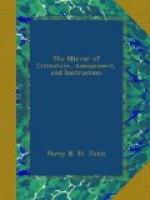The town consists principally of one long and handsome street, at the end of which is an old tower, which formerly defended the Munnow Bridge. There are a few remains of the castle in which Henry V. was born; an elegant and highly ornamented residence “the Castle House,” has been built within its site, and partly of its materials. Monmouth is supposed to be the ancient Blestium. Abergavenny on the Usk is situated in a spot which partakes still more of the character of Welsh scenery: on the south west rises the Blorench mountain, in height 1,720 feet; to the north west the still higher mountain of the Sugar Loaf towers amidst the clouds. To the north east lies St. Michael’s Mountain, or the Great Skyrrid, at one end of which is a remarkable chasm about 300 feet in breadth. The castle at Abergavenny formerly belonged to the Nevilles. The Welsh chroniclers have celebrated the Mountains of Carno, near this place, as having been bedewed with the blood of the Saxons.
The magnificent ruins of Ragland Castle lie half way between Monmouth and Abergavenny. Charles I. was entertained here during the first troubles of his reign, with noble hospitality by the aged Marquess of Worcester, who surrendered the castle, after a siege of almost three months, to the Parliamentary army under Sir Thomas Fairfax, in 1646:
“Majestic Ragland! Harvests
wave
Where thundering hosts their watchword
gave,
When cavaliers, with downcast eye,
Struck the last flag of loyalty.”
BLOOMFIELD.
His son Edward, the second Marquess, was the author of the celebrated “Century of Inventions,” in which the first hint of the steam engine appeared, which he calls “By divine providence, and heavenly inspiration, a stupendous water commanding engine, boundless for height or quantity;” and so delighted was he at the discovery of what he terms “The most stupendous work in the whole world,” that he returned thanks to God for having vouchsafed him an insight into so great a secret of nature. He died in 1667, and his remains were conveyed with mournful solemnity to the cemetery of the Beaufort family in Ragland Church.
The town of Caerleon on the Usk, abounds with Roman remains, and is supposed to have been built on the site of a British town. Giraldus Cambrensis writes that “very eminent men were brought up and taught here,” which countenances the supposition that its real name may have been Cathain Leigean, “the city of learning.”
About two miles to the east of the mouth of the Usk rises Goldcliff, a solitary hill amidst the moors on the banks of the Severn. It derives its name from its glittering appearance when the sun beams on it. “I cannot be persuaded,” says Camden, that “there is a flower here without fruit, were any man to search into the veins, and using the direction of art enter into the inmost and most secret bowels of the earth.”




